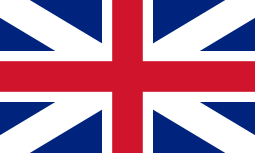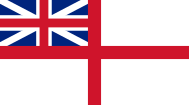 | |
| King's Colour | |
| Use | Civil and state flag |
|---|---|
| Proportion | 3:5 |
| Adopted | 1707 (origin 1606) |
| Relinquished | 1801 |
| Design | Four stripes of white, horizontal, diagonal, and vertical on a blue field, with a red cross in the middle. |
| Red Ensign of Great Britain | |
 | |
| Use | Civil and naval ensign |
| Design | A red field with the flag of Great Britain in the canton |
| Blue Ensign of Great Britain | |
 | |
| Use | Civil and naval ensign |
| Design | A blue field with the flag of Great Britain in the canton |
| White Ensign of Great Britain | |
 | |
| Use | Naval ensign |
| Design | A cross of St George with the flag of Great Britain in the canton |
The flag of Great Britain, often referred to as the King's Colour, first Union Flag,[1][2] Union Jack, and British flag, was used at sea from 1606 and more generally from 1707 to 1801. It was the first flag of the Kingdom of Great Britain.[3][4] It is the precursor to the Union Jack of 1801.
The design was ordered by King James VI and I to be used on ships on the high seas, and it subsequently came into use as a national flag following the Treaty of Union and Acts of Union 1707, gaining the status of "the Ensign armorial of Great Britain", the newly created state. It was later adopted by land forces although the blue of the field used on land-based versions more closely resembled that of the blue of the flag of Scotland.
The flag consists of the red cross of Saint George, patron saint of England, superimposed on the saltire of Saint Andrew, patron saint of Scotland. Its correct proportions are 3:5. The blue field on the flag was sky blue at first, but over time, the blue began to darken.[5]
The flag's official use came to an end in 1801 with the creation of the United Kingdom of Great Britain and Ireland. At that time Saint Patrick's Flag was added to the flag of Great Britain to create the present-day Union Flag.
- ^ Ciara.Berry (2016-01-15). "Union Jack". The Royal Family. Archived from the original on 2022-05-26. Retrieved 2022-06-26.
- ^ "Part 1: The Australian National Flag". Department of the Prime Minister and Cabinet. Archived from the original on 2022-06-26. Retrieved 2022-06-26.
- ^ "British Flags". Flaginstitute.org. Archived from the original on 2015-08-17. Retrieved 2014-10-27.
- ^ "The Union Jack or The Union Flag?". Flaginstitute.org. Archived from the original on 2013-06-13. Retrieved 2014-10-27.
- ^ "History of the Union Flag | UK Flags". The Flag Institute. Archived from the original on 2023-01-07. Retrieved 2023-01-07.